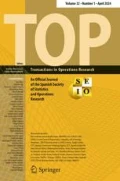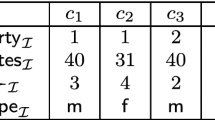Abstract
One of the most active research lines in the area of electoral systems to date deals with the Biproportional Apportionment Problem, which arises in those proportional systems where seats must be allocated to parties within territorial constituencies. A matrix of the vote counts of the parties within the constituencies is given, and one has to convert the vote matrix into an integer matrix of seats “as proportional as possible” to it, subject to the constraints that each constituency be granted its pre-specified number of seats, each party be allotted the total number of seats it is entitled to on the basis of its national vote count, and a zero-vote zero-seat condition be satisfied. The matrix of seats must simultaneously meet the integrality and the proportionality requirement, and this not infrequently gives rise to self-contradictory procedures in the electoral laws of some countries. Here we discuss a class of methods for Biproportional Apportionment characterized by an “error minimization” approach. If the integrality requirement is relaxed, fractional seat allocations (target shares) can be obtained so as to achieve proportionality at least in theory. In order to restore integrality, one then looks for integral apportionments that are as close as possible to the ideal ones in a suitable metric. This leads to the formulation of constrained optimization problems called “best approximation problems” which are solvable in polynomial time through the use of network flow techniques. These error minimization methods can be viewed as an alternative to the classical axiomatic approach introduced by Balinski and Demange (in Math Oper Res 14:700–719, 1989a; Math Program 45:193–210, 1989b). We provide an empirical comparison between these two approaches with a real example from the Italian Elections and a theoretical discussion about the axioms that are not necessarily satisfied by the error minimization methods.


Similar content being viewed by others
Notes
The small differences that the reader may notice between these numbers and the corresponding ones in Serafini and Simeone (2012a) are due to slight differences between the data sets used in the two studies.
We recall here that simplicity is one of the main issues to design fair electoral systems, as stated in the “The Erice Decalogue”, a document that collects the main conclusions of the International Workshop on Mathematics and Democracy: Voting Systems and Collective Choice, Erice, 18–23 September 2005 (Simeone and Pukelsheim 2006).
References
Ahuja RK, Magnanti TL, Orlin JB (1993) Network flows. Theory, algorithms and applications. Prentice Hall, New Jersey
Bacharach M (1965) Estimating nonnegative matrices from marginal data. Int Econ Rev 6:294–310
Bacharach M (1970) Biproportional matrices & input–output change. Cambridge University Press, Cambridge
Balinski ML, Demange G (1989a) An axiomatic approach to proportionality between matrices. Math Oper Res 14:700–719
Balinski ML, Demange G (1989b) Algorithms for proportional matrices in reals and integers. Math Program 45:193–210
Balinski ML, Young HP (2001) Fair representation—meeting the ideal of one man, one vote, 2nd edn. Washington
Berge C, Ghiouila-Houri A (1962) Programming, games and transportation networks. Wiley, New York
Cox LH, Ernst LR (1982) Controlled rounding. Inf Syst Oper Res 20:423–432
Causey BD, Cox LH, Ernst LR (1985) Application of transportation theory to statistical problems. J Am Stat Assoc 80:903–909
Gaffke N, Pukelsheim F (2008a) Vector and matrix apportionment problems and separable convex integer optimization. Math Methods Oper Res 67:133–159
Gaffke N, Pukelsheim F (2008b) Divisor methods for proportional representation systems: an optimization approach to vector and matrix problems. Math Soc Sci 56:166–184
Gassner MB (1989) An impossibility theorem for fair bidimensional representation: towards a biproportional solution. In: Roskam EE (ed) Mathematical psychology in progress. Springer, Berlin, pp 345–365
Gondran M, Minoux M (1979) Graphes et algorithmes. Eyrolles, Paris. (English translation) Graphs and Algorithms. Wiley, New York (1984)
Hochbaum DS (2005) Complexity and algorithms for convex network optimization and other nonlinear problems. 4OR 3:171–216
Leti G (1970) La distribuzione delle tabelle della classe di Frechet. Metron 28:87–119
Minoux M (1984) A polynomial algorithm for minimum quadratic cost flow problems. Eur J Oper Res 18:377–387
Minoux M (1986) Solving integer minimum cost flows with separable convex cost objective polynomially. Math Program Stud 26:237–239
Pennisi A, Ricca F, Simeone B (2005) Legge elettorale con paradosso, La Voce, 11 Novembre 2005 http://www.lavoce.info/
Pennisi A, Ricca F, Simeone B (2006) Bachi e buchi della legge elettorale italiana nell’allocazione biproporzionale di seggi. Sociol Ric Soc 79:55–76
Pennisi A, Ricca F, Serafini P, Simeone B (2007) Amending and enhancing electoral laws through mixed integer programming: the case of Italy. In: Yashin E (ed) Proc VIII international academic conference on economic modernization and social development, Moscow, April 2007, Higher School of Economics
Pennisi A, Ricca F, Serafini P, Simeone B (2008) Ottimizzazione combinatoria per la progettazione di sistemi elettorali. In: Scienza delle decisioni in Italia: applicazioni della ricerca operativa ai problemi aziendali. ECIG, Genova, pp 75–87
Pennisi A, Ricca F, Simeone B (2009) Una legge elettorale sistematicamente erronea. Polena 2:65–72
Pukelsheim F (2004) BAZI: a Java program for proportional representation. Oberwolfach Rep 1:735–737 www.uni-augsburg.de/bazi
Pukelsheim F, Ricca F, Scozzari A, Serafini P, Simeone B (2012) Network flow methods for electoral systems Networks 59:73–88 doi:10.1002/net.20480
Serafini P, Simeone B (2012a) Parametric maximum flow methods for minimax approximation of target quotas in biproportional apportionment. Networks 59:191–208 doi:10.1002/net20434
Serafini P, Simeone B (2012b) Certificates of optimality: the third way to biproportional apportionment. 38:247–268 Soc Choice Welf doi:10.1007/s00355-010-0528-8
Simeone B, Pukelsheim F (2006) Mathematics and democracy: recent advances in voting systems and collective choice. Springer, Berlin
Zachariasen M (2005) Algorithmic aspects of divisor-based biproportional rounding. Technical Report 06/05, Department of Computer Science, University of Copenhagen
Acknowledgements
We are indebted to Professor Michel Minoux for the valuable discussions.
Author information
Authors and Affiliations
Corresponding author
Rights and permissions
About this article
Cite this article
Ricca, F., Scozzari, A., Serafini, P. et al. Error minimization methods in biproportional apportionment. TOP 20, 547–577 (2012). https://doi.org/10.1007/s11750-012-0252-x
Published:
Issue Date:
DOI: https://doi.org/10.1007/s11750-012-0252-x




